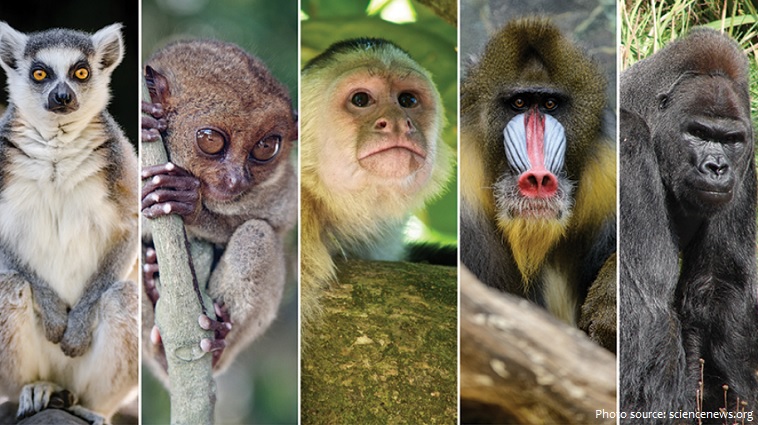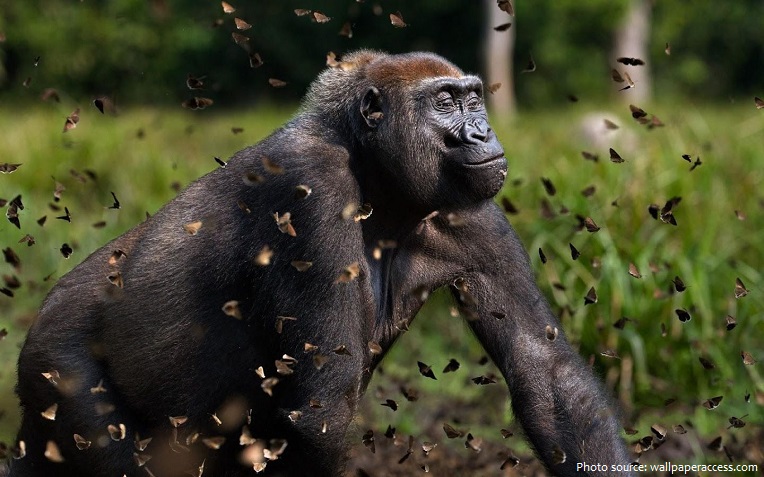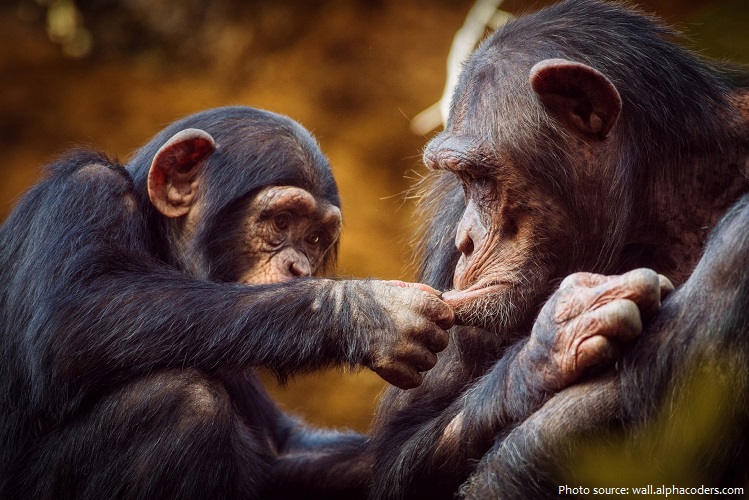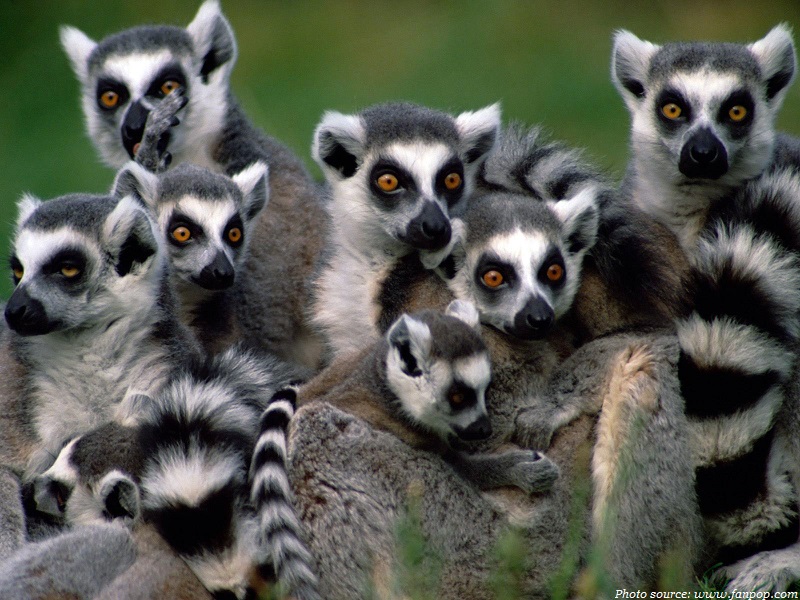
A primate is any mammal of the group that includes lemurs, lorises, tarsiers, monkeys, apes, and humans.
The order Primates, with its 300 or more species, is the third most diverse order of mammals, after rodents and bats.
Although there are some notable variations between some primate groups, they share several anatomic and functional characteristics reflective of their common ancestry.
When compared with body weight, the primate brain is larger than that of other terrestrial mammals, and it has a fissure unique to primates that separates the first and second visual areas on each side of the brain.

Whereas all other mammals have claws or hooves on their digits, only primates have flat nails. Some primates do have claws, but even among these there is a flat nail on the big toe (hallux).
Except for apes including humans, primates such as prosimians and monkeys have tails. Most primates also have opposable thumbs.
The eyes face forward in all primates so that the eyes’ visual fields overlap. Again, this feature is not by any means restricted to primates, but it is a general feature seen among predators. It has been proposed,
therefore, that the ancestor of the primates was a predator, perhaps insectivorous.
Some primates, including gorillas, humans, and baboons, are primarily terrestrial rather than arboreal, but all species have adaptations for climbing trees (in humans this can be seen, for example, in sports like
climbing and parkour).

Non-human primates primarily live in the tropical latitudes of Africa, Asia, and the Americas. Species that live outside of the tropics – include the Japanese macaque which lives in the Japanese islands of Honshū and Hokkaido – the Barbary macaque which lives in North Africa and several species of langur which live in China.
Primates tend to live in tropical rainforests but are also found in temperate forests, savannas, deserts, mountains and coastal areas. The number of primate species within tropical areas has been shown to be positively correlated to the amount of rainfall and the amount of rain forest area.
They are among the most social of animals, forming pairs or family groups, uni-male harems, and multi-male/multi-female groups.

Primates have advanced cognitive abilities: some make tools and use them to acquire food and for social displays – some can perform tasks requiring cooperation, influence and rank – they are status conscious, manipulative and capable of deception – they can recognise kin and conspecifics – and they can learn to use symbols and understand aspects of human language including some relational syntax and concepts of number and numerical sequence.
In 1960, Jane Goodall observed a chimpanzee poking pieces of grass into a termite mound and then raising the grass to his mouth. After he left, Goodall approached the mound and repeated the behaviour because she was unsure what the chimpanzee was doing. She found that the termites bit onto the grass with their jaws. The chimpanzee had been using the grass as a tool to “fish” or “dip” for termites. There are more limited reports of the closely related bonobo using tools in the wild – it has been claimed they rarely use tools in the wild although they use tools as readily as chimpanzees when in captivity. It has been reported that females, both chimpanzee and bonobo, use tools more avidly than males.

The first direct observation of a non-ape primate using a tool in a wild environment occurred in 1988. Primatologist Sue Boinski watched an adult male white-faced capuchin beat a fer-de-lance snake to death with a dead branch. The black-striped capuchin was the first non-ape primate for which routine tool use was documented in the wild – individuals were observed cracking nuts by placing them on a stone anvil and hitting them with another large stone
Fossils of the earliest primates date to the Early Eocene Epoch (56 million to 41.2 million years ago) or perhaps to the Late Paleocene Epoch (59.2 million to 56 million years ago).
The English name “primates” is derived from Old French or French primat, from a noun use of Latin primat-, from primus (‘prime, first rank’). The name was given by Carl Linnaeus because he thought this the “highest” order of animals. The relationships among the different groups of primates were not clearly understood until relatively recently, so the commonly used terms are somewhat confused. For example, ape has been used either as an alternative for monkey or for any tailless, relatively human-like primate.

Thousands of non-human primates are used around the world in research because of their psychological and physiological similarity to humans. In particular, the brains and eyes of NHPs more closely parallel human anatomy than those of any other animals. NHPs are commonly used in preclinical trials, neuroscience, ophthalmology studies, and toxicity studies.
In Asia, Hinduism, Buddhism, and Islam prohibit eating primate meat – however, primates are still hunted for food. Some smaller traditional religions allow the consumption of primate meat. The pet trade and traditional medicine also increase demand for illegal hunting. The rhesus macaque, a model organism, was protected after excessive trapping threatened its numbers in the 1960s – the program was so effective that they are now viewed as a pest throughout their range.

By the 21st century the populations of approximately 75 percent of all primate species were falling, and some 60 percent were considered either threatened or endangered species. Habitat loss and fragmentation from logging, mining, urban sprawl, and the conversion of natural areas to agriculture and livestock raising are the primary threats to many species. Other causes of widespread population declines include hunting and poaching, the pet trade, the illegal trade in primate body parts, and the susceptibility of some primates to infection with human diseases.
There are 21 critically endangered primates, 7 of which have remained on the IUCN’s “The World’s 25 Most Endangered Primates” list since the year 2000: the silky sifaka, Delacour’s langur, the white-headed langur, the gray-shanked douc, the Tonkin snub-nosed monkey, the Cross River gorilla and the Sumatran orangutan. Miss Waldron’s red colobus was recently declared extinct when no trace of the subspecies could be found from 1993 to 1999. A few hunters have found and killed individuals since then, but the subspecies’ prospects remain bleak.